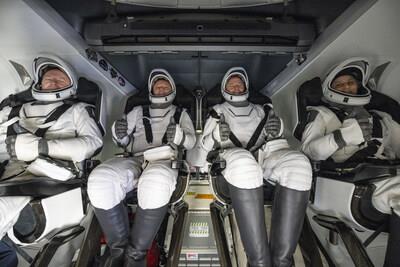
NASA's Spacex Crew-9 Astronauts To Discuss Science Mission
Watch live coverage on NASA+ . Learn how to watch NASA content through a variety of additional platforms, including social media.
Media are invited to attend in person or virtually. U.S. media requesting in-person attendance or media seeking an interview with the crew must contact the NASA Johnson newsroom no later than 5 p.m. on Friday, March 28, at 281-483-5111 or [email protected] . A copy of NASA's media accreditation policy is available on the agency's website. Media participating by phone must dial into the news conference no later than 10 minutes before the start of the event to ask questions. Questions also may be submitted on social media using #AskNASA.
Hague and Gorbunov lifted off at 1:17 p.m. Sept. 28, 2024, on a SpaceX Falcon 9 rocket from Space Launch Complex 40 at Cape Canaveral Space Force Station in Florida. The next day, they docked to the forward-facing port of the station's Harmony module. Williams and Wilmore launched aboard Boeing's Starliner spacecraft and United Launch Alliance Atlas V rocket on June 5, 2024, from Space Launch Complex 41 as part of the agency's Boeing Crew Flight Test. The duo arrived at the space station on June 6. In August, NASA announced the uncrewed return of Starliner to Earth and integrated Wilmore and Williams as part of the space station's Expedition 71/72 for a return on Crew-9.
Williams and Wilmore traveled 121,347,491 miles during their mission, spent 286 days in space, and completed 4,576 orbits around Earth. Hague and Gorbunov traveled 72,553,920 miles during their mission, spent 171 days in space, and completed 2,736 orbits around Earth.
Hague, Williams, and Wilmore completed over 900 hours of research , conducting more than 150 unique experiments. During their time in orbit, the crew studied plant growth and development, tested stem cell technology to improve patient outcomes on Earth, and participated in research to understand how the space environment affects material degradation. They also performed a spacewalk and collected samples from the station's exterior, studying the survivability of microorganisms in space. Additionally, the crew supported 30 ham radio events with students worldwide and conducted a student-led genetic experiment, helping to inspire the next generation of explorers.
NASA's Commercial Crew Program has delivered on its goal of safe, reliable, and cost-effective transportation to and from the International Space Station from the United States through a partnership with American private industry. This partnership is changing the arc of human spaceflight history by opening access to low Earth orbit and the International Space Station to more people, more science, and more commercial opportunities. The space station remains the springboard to NASA's next great leap in space exploration, including future missions to the Moon and, eventually, to Mars.
Find more information on NASA's Commercial Crew Program at:
SOURCE NASA

Legal Disclaimer:
MENAFN provides the
information “as is” without warranty of any kind. We do not accept
any responsibility or liability for the accuracy, content, images,
videos, licenses, completeness, legality, or reliability of the information
contained in this article. If you have any complaints or copyright
issues related to this article, kindly contact the provider above.


















Comments
No comment